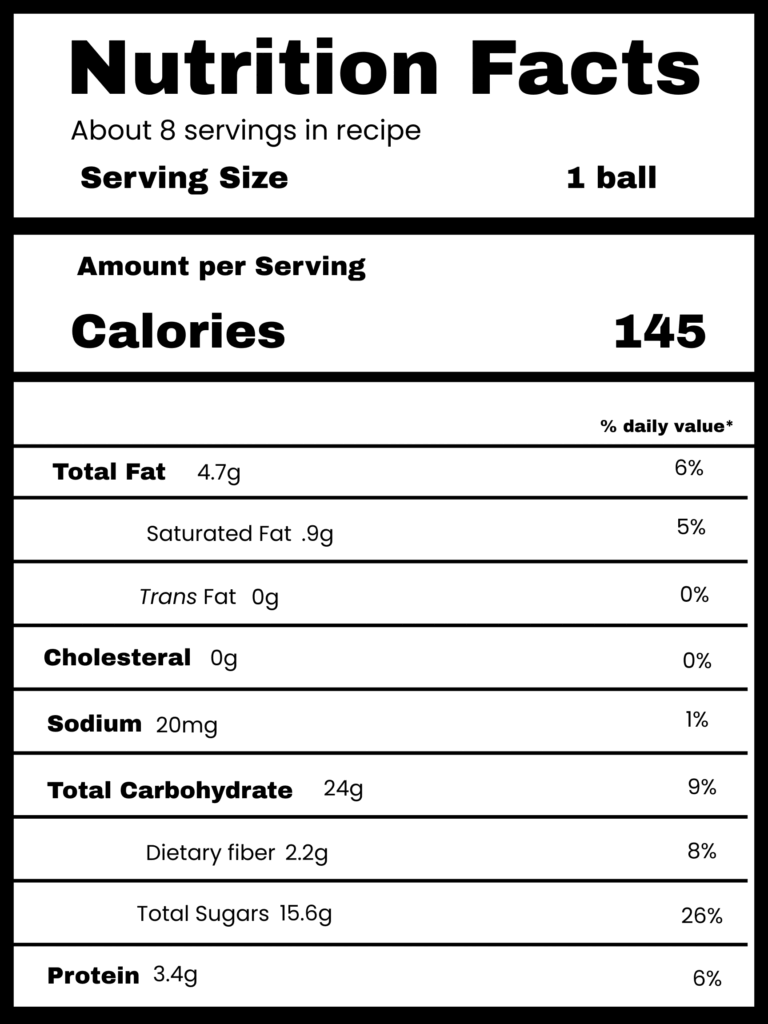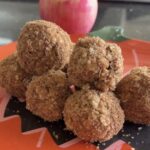Apple Cinnamon Sugar Energy Bites
The Surprising Benefits of Oats in Your Diet
Oats are more than just a cozy breakfast option. They’re a nutritional powerhouse that can support your heart, gut, and overall how you feel. Let’s explore how incorporating oats into your daily routine can offer surprising health benefits.
Heart Health: Lowering Cholesterol Naturally
Oats are rich in a type of soluble fiber called beta-glucan, which has been shown to lower levels of total and LDL (“bad”) cholesterol. A systematic review of 13 randomized controlled trials found that oat beta-glucan intake significantly decreased total and LDL cholesterol levels, contributing to a reduced risk of cardiovascular disease. MDPI
The U.S. Food and Drug Administration (FDA) recognizes the heart-health benefits of beta-glucan, allowing foods containing at least 3 grams of oat beta-glucan per serving to make health claims related to cholesterol reduction Healthline
Gut Health: Nourishing Your Microbiome
These also support a healthy gut microbiome and bowel movements. Studies have shown that oats can increase the abundance of beneficial gut bacteria, such as Bifidobacterium and Lactobacillus species. PMC
These beneficial bacteria produce short-chain fatty acids (SCFAs) during fermentation, which play a crucial role in maintaining gut health and may reduce inflammation. Frontiers
Oats and Digestive Health: Keeping Your Bowels Happy
Because of soluble and insoluble fibers, oats can help regulate bowel movements and promote a healthy gut.
- Soluble fiber (beta-glucan): This fiber forms a gel-like substance in your digestive tract, slowing digestion and helping your body absorb nutrients efficiently. It also softens stools, making them easier to pass.
- Insoluble fiber: Found in the oat bran and hull, insoluble fiber adds bulk to your stool, encouraging regularity and preventing constipation.
Research shows that eating fiber-rich foods like oats can improve stool frequency and consistency, reducing the likelihood of irregular bowel movements. (Harvard T.H. Chan School of Public Health)
Additionally, oats act as a prebiotic, feeding beneficial gut bacteria that produce short-chain fatty acids. These compounds not only support a healthy gut lining but may also help reduce inflammation and maintain overall gut function. (PMC, National Library of Medicine)
In short, adding oats to increase your fiber intake can help keep your digestive system running smoothly, making both your gut and your day feel lighter and more energized. This is beneficial for healthy consistent bowel movements.
Best time to Eat Energy Bites
Best Time to Eat Energy Bites
Energy bites are small, nutrient-packed snacks, but timing can make a big difference in how well your body uses that energy.
1. Mid-Morning or Mid-Afternoon Snack
These are the classic “pick-me-up” moments. Between meals, your blood sugar can dip, leaving you feeling sluggish or reaching for less-healthy snacks. A single energy bite (or two, depending on size) provides energy to keep you steady until your next meal.
2. Pre-Workout Fuel
Eating an energy bite 30–60 minutes before exercise can give you a gentle boost. The carbs supply quick energy, while the protein and healthy fats help sustain you during longer workouts. This is especially useful for morning or lunchtime gym sessions.
3. Post-Workout Recovery
After exercise, your body needs nutrients to refuel glycogen stores and repair muscles. A small energy bite paired with water or and a protein source can provide that recovery fuel without feeling heavy.
4. Anytime You Need a Brain Boost
Oats, peanut butter, and natural sweeteners provide a slow-release energy source—perfect for tackling that afternoon slump, long study session, or mid-meeting fatigue.
Pro Tip: Because energy bites are calorie-dense, sticking to 1–2 bites per snack is usually plenty unless you’re using them as a meal replacement in a pinch.
Energy Balls Vs Protein Bars
When it comes to quick, portable snacks, energy balls and protein bars often seem like simple options. While both can fuel your day, there are some key differences to help you decide which is best for you in that moment.
1. Ingredients & Nutrition
Energy balls are usually made from whole-food ingredients such as oats, nut butter, dried fruit, seeds, and a touch of natural sweetener. This means they provide fiber, healthy fats, and vitamins along with protein.
Protein bars, on the other hand, vary widely. Some are whole-food based, but many are highly processed, with added sugars, syrups, or protein isolates. While they often pack more protein per serving, the trade-off can be lower fiber and more additives.
2. Protein Content
A typical energy ball contains 3–5 grams of protein, enough for a snack or a mini pre/post-workout boost. Protein bars often range from 10–20 grams of protein, making them more suitable if you’re looking specifically for muscle repair or meal replacement.
3. Sugar & Satiety
Energy balls generally use natural sweeteners like honey, maple syrup, or dates, giving you a moderate sugar content with slow-release energy from fiber and healthy fats. Many protein bars, especially commercial brands, have higher sugar content or sugar alcohols that can cause digestive discomfort in some people.
4. Convenience & Customization
Energy balls are easy to make at home, letting you control ingredients, flavors, and portion sizes. Protein bars are convenient for on-the-go situations, but homemade energy balls let you tailor them to dietary needs (gluten-free, vegan, nut-free, etc.).
Bottom Line:
- Choose energy balls if you want a whole-food snack that’s customizable, fiber-rich, and lightly sweet.
- Choose protein bars if you need higher protein for muscle recovery or a meal replacement in a pinch.
For most everyday snack needs, energy balls hit the sweet spot of nutrition, taste, and simplicity—all in a cozy little bite!
| Feature | Energy Balls | Protein Bars |
|---|---|---|
| Main Ingredients | Oats, nut butter, dried fruit, seeds, natural sweeteners | Protein isolates, nuts, sweeteners, sometimes chocolate or fillers |
| Protein Content | 3–5 g per bite | 10–20 g per bar |
| Fiber | Moderate (from oats, fruit, seeds) | Often lower unless specifically added |
| Sugar | Natural sugars from honey, maple syrup, or dates | Can be higher; sometimes sugar alcohols or syrups |
| Processing | Minimal; often homemade | Can be heavily processed, store-bought |
| Customization | Easy to make vegan, gluten-free, nut-free | Limited; depends on brand |
| Best For | Everyday snack, pre/post workout boost, fiber-rich energy | Muscle recovery, meal replacement, higher protein need |
Apple Cinnamon Sugar Energy Bites
Ingredients
-
1 cup rolled oats
-
½ cup dried apples, finely chopped
-
¼ cup peanut butter
-
¼ cup honey or maple syrup
-
1 tsp vanilla extract
-
1 tsp cinnamon
-
Pinch of salt
Extra ingredients for the coating:
– 2 Tbsp brown sugar
– ½ tsp cinnamon
Instructions
1. In a medium bowl, stir together oats, dried apples, cinnamon, and salt.
2. Add peanut butter, honey/maple, and vanilla. Mix until everything sticks together. If too dry, add a splash more honey/maple. If not sticking enough, add a bit more peanut butter
3. Scoop mixture and roll into 8 balls.
4. In a small bowl, mix coconut sugar + cinnamon. Roll each ball lightly in the mixture for a sweet coating.
5. Refrigerate 20–30 minutes to firm up. Store in an airtight container in the fridge for up to a week.


